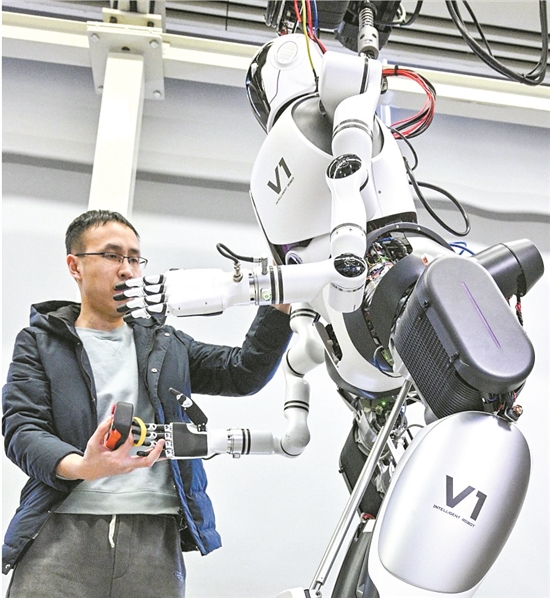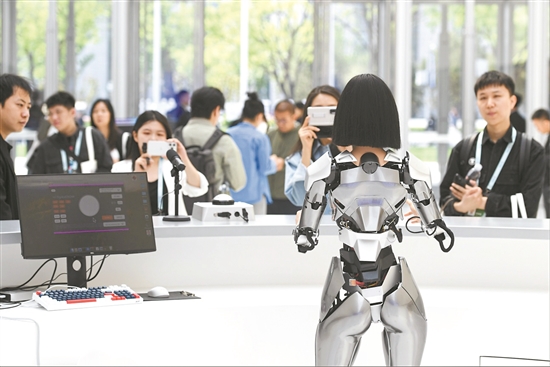
Recently, Tesla Optimus released a 90-second demo video showcasing its robot Optimus working at a Tesla factory. In the footage, Optimus is sorting batteries along the production line, while the operator is using VR glasses and gloves to remotely collect data. Industry insiders see this as a significant advancement towards Optimus potentially replacing human workers in factories.

Globally, technology companies are betting on humanoid robots and are experimenting with their use in logistics, warehousing, retail, and manufacturing sectors to perform tasks that are either dangerous or monotonously repetitive. Before Optimus's operational upgrade, humanoid robots in China had already begun their "work careers". In February 2024, UBTECH Robotics, headquartered in Shenzhen, released a video of its humanoid robot in industrial settings, Walker S, undergoing"practical training" at NIO's car factory. At this factory, Walker S performs quality checks on door locks, seat belts, and headlamp covers, and even applies logos to new cars.
In March, OpenAI in collaboration with Figure launched the versatile robot, Figure 01, and NVIDIA announced its humanoid robot project, GR00T. In April, Boston Dynamics introduced an electric version of its humanoid robot, Atlas, first launched in 2013. Noteworthy this month, the Beijing Humanoid Robot Innovation Center unveiled "Tiangong" in Beijing, the world's first full-size humanoid robot capable of running stably at speeds of 6 km/h.

Will humanoid robots become the next trillion-dollar blue ocean market opportunity? How will they be applied as common household items? According to Goldman Sachs, under ideal technological breakthroughs, humanoid robots could achieve a compound annual growth rate of 94% in sales from 2025 to 2035, potentially reaching a market size of 154 billion dollars by 2035. Goldman Sachs forecasts that the widespread adoption of robots could significantly alleviate labor shortages in sectors like manufacturing and elderly care.
According to CCID's research on the ecological development of China's humanoid robot industry in 2024, the humanoid robot industry experienced a surge in 2023. Established players leveraged the momentum to grow and even go public, while numerous powerful innovative startups emerged, boosting the industry's scale to 3.91 billion yuan, a year-on-year increase of 85.7%. The market is expected to continue its rapid growth in 2024 and 2025, with the Chinese humanoid robot industry projected to exceed 20 billion yuan by 2026.
Despite the growing excitement around humanoid robots, there remains a gap before they become a part of everyday life. Jianwei Zhang, a foreign academician of the Chinese Academy of Engineering and an academician of ACATECH, believes that "Robots must integrate technologies like AI, VR, AR, new materials, and new energy to revolutionize future technological applications."
Source :Yangcheng Evening News
广东产机器人比 Optimus 更早进厂打工 | In Guangdong We Trust
近日,Tesla Optimus官方发布了一段Optimus机器人在特斯拉工厂中“打工”的90秒演示视频,在该视频当中,Optimus正在生产线上分拣电池,操作人员戴着VR眼镜和手套,通过远程操作的方式来采集数据。业内则将此视为Optimus离实现“取代真人员工进厂打工”再进一步。
从全球来看,已有多家科技公司正在押注于人形机器人赛道,并尝试在物流、仓储、零售和制造等行业替代人类,执行可能存在危险或较为乏味的重复性任务。在Optimus“进厂打工”再升级之前,国内的人形机器人已开启了“打工生涯”,总部位于深圳的优必选曾于今年2月发布了工业版人形机器人Walker S在蔚来的汽车工厂进行“实训”的视频。在蔚来的汽车工厂里,Walker S进行着车门锁质检、安全带检测、车灯盖板质检,并走到车头给新车贴上车标。
今年3月,OpenAI和Figure合作推出通用型机器人Figure 01,英伟达公布人形机器人项目GR00T;就在今年4月,波士顿动力宣布自2013年发布的Atlas人形机器人推出电动版。值得注意的是,同样在这个月,由北京人形机器人创新中心发布的能以6公里/小时速度稳定奔跑的“天工”也亮相北京,“天工”也是全球首个纯电驱拟人奔跑的全尺寸人形机器人。
人形机器人是下一个万亿蓝海吗?又将如何飞入寻常百姓家?据高盛预测,在技术得到革命性突破的理想情况下,人形机器人2025年至2035年销量复合年均增长率可达94%,2035年市场规模将达1540亿美元。在高盛看来,未来制造业和老年人护理等行业的劳动力短缺问题,将随着机器人的普及应用而在很大程度上得到解决。
赛迪研究院发布的《2024中国人形机器人产业生态发展研究》数据显示,2023年,人形机器人产业进入爆发期,“行业老兵”乘势发展壮大甚至成功上市,同时涌现出一批有较强创新实力的初创企业,产业规模增长至39.1亿元,同比增长85.7%;预计2024年、2025年人形机器人产业将持续高速增长,2026年中国人形机器人产业规模将突破200亿元。
不过,尽管人形机器人“浪潮”汹涌,但它距离进入日常生活仍有距离。在中国工程院外籍院士、德国国家工程院院士张建伟看来,“机器人要叠加人工智能、VR、AR、新材料、新能源等技术应用,才能在未来创造颠覆性的技术应用”。
文|记者 许张超
译|邹晓华
-
Indulge in seafood delights at Doumen! The unique allure of 'Baitengtou'
2024-05-09 23:10:35 -
County-level tourism emerges as a new trend during May Day holiday
2024-05-09 23:10:53 -
SHEIN becomes the third largest online fashion retailer in the United States
2024-05-09 23:17:59 -
Video|From Guangzhou to Paris: Wanglaoji's presence at Sino-French Food Carnival
2024-05-09 23:11:59






